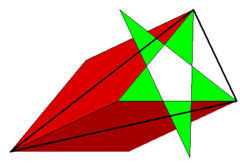Pentagrammic prism
Appearance
This article has multiple issues. Please help improve it or discuss these issues on the talk page. (Learn how and when to remove these template messages)
|
| Uniform pentagrammic prism | |
|---|---|

| |
| Type | Prismatic uniform polyhedron |
| Elements | F = 7, E = 15 V = 10 (χ = 2) |
| Faces by sides | 5{4}+2{5/2} |
| Schläfli symbol | t{2,5/2} or {5/2}×{} |
| Wythoff symbol | 2 5/2 | 2 |
| Coxeter diagram | |
| Symmetry | D5h, [5,2], (*522), order 20 |
| Rotation group | D5, [5,2]+, (522), order 10 |
| Index references | U78(a) |
| Dual | Pentagrammic dipyramid |
| Properties | nonconvex |
 Vertex figure 4.4.5/2 | |

In geometry, the pentagrammic prism is one of an infinite set of nonconvex prisms formed by square sides and two regular star polygon caps, in this case two pentagrams.
It has 7 faces, 15 edges and 10 vertices. This polyhedron is identified with the indexed name U78 as a uniform polyhedron.[1]
It is a special case of a right prism with a pentagram as base, which in general has rectangular non-base faces.
The pentagram face has an ambiguous interior because it is self-intersecting. The central pentagon region can be considered interior or exterior depending on how the interior is defined. One definition of the interior is the set of points that have a ray that crosses the boundary an odd number of times to escape the perimeter.
Gallery
 An alternative representation with hollow centers to the pentagrams. |
 The pentagrammic dipyramid is the dual to the pentagrammic prism. |
References
- ^ Maeder, Roman. "78: pentagrammic prism". MathConsult.
{{cite web}}: CS1 maint: url-status (link)
External links
- Weisstein, Eric W. "Pentagrammic prism". MathWorld.
- Weisstein, Eric W. "Pentagrammic dipyramid". MathWorld.
- http://www.mathconsult.ch/showroom/unipoly/78.html
- http://bulatov.org/polyhedra/uniform/u03.html
- Paper model of pentagrammic prism
- https://web.archive.org/web/20050313234702/http://www.math.technion.ac.il/~rl/kaleido/data/03.html
- http://home.comcast.net/~tpgettys/nonconvexprisms.html
- https://web.archive.org/web/20060211140715/http://www.ac-noumea.nc/maths/amc/polyhedr/no_conv5_.htm
- Paper Model (net) Pentagrammic Prism
